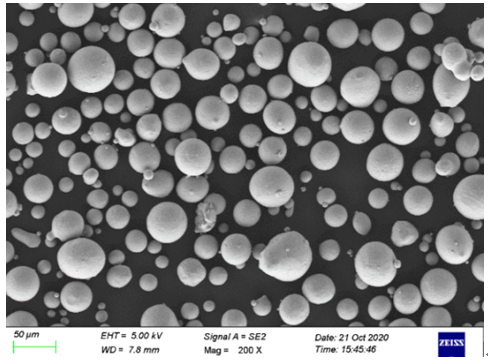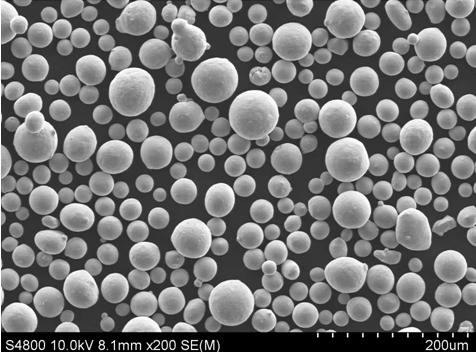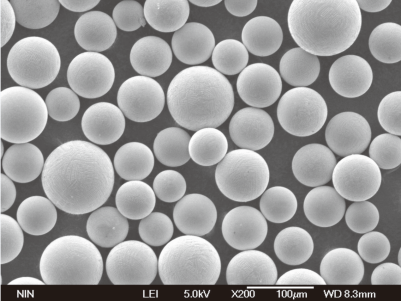Einführung
Hochreines Eisenpulver ist ein wichtiger Werkstoff, der in verschiedenen Industriezweigen, von der Metallurgie bis zur Elektronik, verwendet wird. Aber was genau macht es so besonders? Wie unterscheidet es sich von normalem Eisenpulver? In diesem Leitfaden tauchen wir tief in die Welt des hochreinen Eisenpulvers ein und erforschen seine Zusammensetzung, Eigenschaften, Anwendungen und vieles mehr. Ob Sie nun ein erfahrener Fachmann oder ein neugieriger Lernender sind, dieser Artikel soll all Ihre Fragen über hochreines Eisenpulver beantworten.
Überblick über hochreines Eisenpulver
Hochreines Eisenpulver ist Eisenpulver mit einem Reinheitsgrad von 99,9 % oder mehr. Aufgrund seiner einzigartigen Eigenschaften eignet es sich ideal für spezielle Anwendungen, die eine hohe Festigkeit, hervorragende Leitfähigkeit oder besondere magnetische Eigenschaften erfordern. Bei der Herstellung von hochreinem Eisenpulver kommen fortschrittliche Verfahren wie Zerstäubung oder Reduktion zum Einsatz, die zu einem feinen Pulver mit gleichmäßiger Partikelgröße und -form führen.
Hauptmerkmale des hochreinen Eisenpulvers
- Reinheit: In der Regel 99,9 % oder höher
- Partikelgröße: Kann von einigen Mikrometern bis zu mehreren hundert Mikrometern reichen
- Form: Kugelförmig oder unregelmäßig, je nach Herstellungsverfahren
- Magnetische Eigenschaften: Hohe Sättigungsmagnetisierung
- Elektrische Leitfähigkeit: Ausgezeichnet aufgrund des hohen Reinheitsgrades

Zusammensetzung und Eigenschaften des hochreinen Eisenpulvers
| Eigentum | Beschreibung |
|---|---|
| Reinheit | 99.9% oder höher |
| Partikelgröße | Von einigen Mikrometern bis zu mehreren hundert Mikrometern |
| Form | Kugelförmig oder unregelmäßig |
| Magnetische Sättigung | Hoch |
| Elektrische Leitfähigkeit | Ausgezeichnet durch minimale Verunreinigungen |
| Dichte | Variiert je nach Größe und Form der Partikel |
| Fläche | Höher bei feineren Pulvern |
| Sauerstoffgehalt | Gering, dadurch minimale Oxidation |
Arten und Modelle von Hochreines Eisenpulver
Es gibt verschiedene Arten von hochreinem Eisenpulver, die jeweils auf bestimmte Anwendungen zugeschnitten sind. Die Unterschiede zwischen diesen Typen liegen in der Partikelgröße, der Form und den Produktionsmethoden. Im Folgenden werden einige der gängigsten auf dem Markt erhältlichen Modelle vorgestellt:
1. Zerstäubtes Eisenpulver
Zerstäubtes Eisenpulver wird durch den Zerstäubungsprozess hergestellt, bei dem geschmolzenes Eisen in feine Tröpfchen dispergiert wird, die sich zu Pulver verfestigen. Dieser Typ hat in der Regel eine kugelförmige Form und wird für Anwendungen verwendet, bei denen Fließfähigkeit und Packungsdichte wichtig sind.
- Reinheit: 99,9% oder höher
- Anwendungen: Pulvermetallurgie, magnetische Werkstoffe, Metall-Spritzguss (MIM)
2. Reduziertes Eisenpulver
Reduziertes Eisenpulver wird durch Reduktion von Eisenerz oder Walzzunder in einer Wasserstoffatmosphäre hergestellt. Es hat in der Regel eine unregelmäßige Form und wird in Anwendungen eingesetzt, bei denen die Oberfläche von entscheidender Bedeutung ist, z. B. bei chemischen Reaktionen oder als Katalysator.
- Reinheit: 99,5% bis 99,9%
- Anwendungen: Chemische Synthese, pharmazeutische Industrie, magnetische Materialien
3. Elektrolytisches Eisenpulver
Elektrolytisches Eisenpulver wird durch die Elektrolyse von Eisen hergestellt. Dieses Verfahren führt zu einer sehr hohen Reinheit und einer kontrollierten Partikelgrößenverteilung. Es wird häufig für Anwendungen verwendet, die hohe Präzision und Reinheit erfordern.
- Reinheit: 99,9% oder höher
- Anwendungen: Elektronik, Batterieherstellung, Hochleistungsmagnete
4. Carbonyl-Eisen-Pulver
Carbonyleisenpulver wird durch Zersetzung von Eisenpentacarbonyl hergestellt. Bei diesem Verfahren entstehen ultrafeine kugelförmige Partikel, die häufig in Anwendungen eingesetzt werden, die eine hohe Magnetisierung und minimale Verunreinigungen erfordern.
- Reinheit: 99,9% oder höher
- Anwendungen: Elektronik, Induktoren, elektromagnetische Abschirmung
5. Wasser-Atomisiertes Eisen-Pulver
Ähnlich wie zerstäubtes Eisenpulver, aber mit Wasser als Dispersionsmittel, hat wasserverdüstes Eisenpulver unregelmäßige Formen und wird dort eingesetzt, wo ein Gleichgewicht zwischen Kosten und Leistung erforderlich ist.
- Reinheit: 99,5% bis 99,9%
- Anwendungen: Pulvermetallurgie, Automobilteile, Metall-Spritzguss (MIM)
6. Gas-Atomisiertes Eisen-Pulver
Gasverdüstes Eisenpulver, das unter Verwendung von Inertgasen zur Dispersion des geschmolzenen Eisens hergestellt wird, hat in der Regel eine gleichmäßigere Kugelform und wird für Hochleistungsanwendungen verwendet.
- Reinheit: 99,9% oder höher
- Anwendungen: Luft- und Raumfahrt, 3D-Druck, magnetische Materialien
7. Ultrafeines Eisenpulver
Ultrafeines Eisenpulver zeichnet sich durch seine extrem kleine Partikelgröße aus, die oft im Nanometerbereich liegt. Es wird in fortschrittlichen Anwendungen wie Beschichtungen, Druckfarben und Nanotechnologie eingesetzt.
- Reinheit: 99,9% oder höher
- Anwendungen: Beschichtungen, Nanotechnologie, leitfähige Druckfarben
8. Hochdichtes Eisenpulver
Eisenpulver mit hoher Dichte ist für Anwendungen bestimmt, die eine maximale Packungsdichte erfordern, und wird typischerweise in der Hochleistungsmetallurgie verwendet.
- Reinheit: 99,7% bis 99,9%
- Anwendungen: Luft- und Raumfahrt, Automobilindustrie, Schwermaschinenbau
9. Magnetisches Eisenpulver
Magnetisches Eisenpulver wird speziell verarbeitet, um seine magnetischen Eigenschaften zu verbessern, und wird in Anwendungen wie Induktoren, Transformatoren und magnetischen Abschirmungen verwendet.
- Reinheit: 99,9% oder höher
- Anwendungen: Transformatoren, Induktoren, magnetische Abschirmung
10. Sprühgeformtes Eisenpulver
Sprühgeformtes Eisenpulver wird in einem schnellen Erstarrungsprozess hergestellt, was zu einer einzigartigen Mikrostruktur führt, die verbesserte mechanische Eigenschaften bietet.
- Reinheit: 99,8% bis 99,9%
- Anwendungen: Werkzeugbau, Strukturteile, Hochleistungslegierungen
Anwendungen von hochreinem Eisenpulver
Hochreines Eisenpulver wird aufgrund seiner außergewöhnlichen Eigenschaften in einer Vielzahl von Branchen eingesetzt. Seine Anwendungen reichen von der traditionellen Metallurgie bis hin zu modernster Elektronik und Nanotechnologie.
Tabelle: Anwendungen des hochreinen Eisenpulvers
| Anwendungsbereich | Beschreibung |
|---|---|
| Pulvermetallurgie | Wird zur Herstellung hochfester Präzisionsteile durch Sintern und andere Verfahren verwendet. |
| Elektronik | Unverzichtbar für die Herstellung von Bauteilen wie Induktoren, Kondensatoren und Transformatoren. |
| Magnetische Materialien | Sie werden zur Herstellung von Hochleistungsmagneten für verschiedene Anwendungen, einschließlich Motoren und Sensoren, verwendet. |
| Chemische Synthese | Dient als Katalysator bei chemischen Reaktionen und wird bei der Herstellung von Kunststoffen verwendet. |
| Pharmazeutika | Wird aufgrund seiner hohen Reinheit bei der Herstellung bestimmter Arzneimittelformulierungen verwendet. |
| Nanotechnologie | Wird in fortschrittlichen Materialien und Beschichtungen verwendet, oft im Nanobereich. |
| Batterieherstellung | Wird bei der Herstellung von Hochleistungsbatterien verwendet, insbesondere bei den Kathoden- und Anodenmaterialien. |
| Additive Fertigung | Unverzichtbar für den 3D-Druck und andere additive Fertigungsverfahren, die feine, gleichmäßige Pulver liefern. |
| Elektromagnetische Abschirmung | Wird zur Herstellung von Materialien verwendet, die elektronische Geräte vor elektromagnetischen Störungen schützen. |
| Hochleistungs-Legierungen | Wird Legierungen zugesetzt, um deren mechanische Eigenschaften zu verbessern, insbesondere in der Luft- und Raumfahrt und in der Automobilindustrie. |






Spezifikationen, Größen, Güteklassen und Normen
Bei der Auswahl von hochreinem Eisenpulver ist es entscheidend, die geltenden Spezifikationen, Größen, Qualitäten und Normen zu kennen. Diese Parameter können je nach Anwendung variieren, und die richtige Wahl kann die Leistung erheblich beeinflussen.
Tabelle: Spezifikationen des hochreinen Eisenpulvers
| Spezifikation | Beschreibung |
|---|---|
| Reinheitsgrade | 99.5% bis 99,9% oder höher |
| Partikelgrößenbereich | Von Nanometern (nm) bis zu mehreren hundert Mikrometern (µm) |
| Güteklassenstandards | ASTM, ISO, JIS, je nach Branche |
| Verfügbare Formen | Kugelförmig, unregelmäßig, flockig |
| Produktionsverfahren | Zerstäubung, Reduktion, elektrolytisch, Carbonyl |
| Dichtebereich | Abhängig von der Partikelgröße und -form; typischerweise 2,5-7,8 g/cm³ |
| Magnetische Eigenschaften | Hohe Sättigungsmagnetisierung, niedrige Koerzitivfeldstärke |
| Leitfähigkeit | Hohe elektrische Leitfähigkeit aufgrund minimaler Verunreinigungen |
Tabelle: Qualitäten von hochreinem Eisenpulver
| Klasse | Reinheitsgrad | Anwendungen |
|---|---|---|
| Note A | 99.9% oder höher | Elektronik, medizinische Geräte, Hochleistungsmagnete |
| Note B | 99.7% bis 99,9% | Pulvermetallurgie, chemische Synthese |
| Raster C | 99.5% bis 99,7% | Additive Fertigung, Automobilkomponenten |
| Note D | 99.0% bis 99,5% | Allgemeine Metallurgie, Werkzeugbau, Strukturteile |
Lieferanten und Preisangaben von Hochreines Eisenpulver
Die Verfügbarkeit und die Kosten von hochreinem Eisenpulver können je nach Anbieter, Region und spezifischen Produktanforderungen erheblich variieren. Im Folgenden finden Sie eine Übersicht über einige der führenden
lieferanten und deren Preisangaben.
Tabelle: Lieferanten und Preisgestaltung für hochreines Eisenpulver
| Anbieter | Standort | Produktpalette | Preisspanne (pro kg) |
|---|---|---|---|
| Hoganas AB | Schweden | Zerstäubte, reduzierte, elektrolytische Pulver | $50 – $200 |
| JFE Steel Corporation | Japan | Hochreines Eisenpulver für Elektronik und Metallurgie | $80 – $250 |
| Rio Tinto Metall-Pulver | Kanada | Gaszerstäubte, wasserzerstäubte Pulver | $60 – $180 |
| BASF | Deutschland | Carbonyleisenpulver, ultrafeine Pulver | $100 – $300 |
| GKN Pulvermetallurgie | USA | Hochdichte, magnetische Eisenpulver | $70 – $220 |
| Mitsui Mining & Smelting | Japan | Spritzgeformte, ultrahochreine Pulver | $90 – $280 |
| CNPC-Pulver-Gruppe | China | Reduzierte, zerstäubte, elektrolytische Pulver | $40 – $150 |
| Kobe-Stahl | Japan | Spezialsorten für anspruchsvolle Anwendungen | $110 – $320 |
| Sandvik Werkstofftechnik | Schweden | Hochleistungseisenpulver für die Luft- und Raumfahrt und die Automobilindustrie | $120 – $350 |
| Amerikanische Elemente | USA | Nanopartikel, ultrafeine Pulver | $200 – $500 |
Vorteile und Grenzen des hochreinen Eisenpulvers
Wie jedes Material hat auch hochreines Eisenpulver seine eigenen Vorteile und Grenzen. Diese zu verstehen, kann bei der Auswahl des richtigen Typs für Ihre Anwendung helfen.
Tabelle: Vorteile und Grenzen des hochreinen Eisenpulvers
| Vorteile | Beschränkungen |
|---|---|
| Hohe Festigkeit | Ideal für Anwendungen, die robuste mechanische Eigenschaften erfordern |
| Ausgezeichnete magnetische Eigenschaften | Perfekt für magnetische Materialien und elektromagnetische Abschirmung |
| Hohe Reinheit | Reduziert Verunreinigungen und verbessert die Leitfähigkeit und Leistung |
| Vielseitige Anwendungen | Kann in einer Vielzahl von Branchen eingesetzt werden, von der Elektronik bis zur Pharmazie |
| Personalisierung | Erhältlich in verschiedenen Qualitäten, Größen und Formen, die den jeweiligen Anforderungen entsprechen |
| Kosten | Höhere Reinheitsgrade können teuer sein |
| Komplexität der Produktion | Erfordert fortschrittliche Produktionsmethoden, die die Verfügbarkeit einschränken können |
| Eingeschränkte Lieferanten | Nicht so weit verbreitet wie minderwertige Eisenpulver |
| Oxidations-Empfindlichkeit | Hochreines Eisen kann anfälliger für Oxidation sein und erfordert eine sorgfältige Lagerung |
Vergleich zwischen hochreinem Eisenpulver und anderen Metallpulvern
Wie schneidet hochreines Eisenpulver im Vergleich zu anderen Arten von Metallpulvern ab? Vergleichen wir es mit einigen häufig verwendeten Alternativen:
Tabelle: Vergleich des hochreinen Eisenpulvers mit anderen Metallpulvern
| Metall-Pulver | Reinheitsgrad | Anwendungen | Vorteile | Beschränkungen |
|---|---|---|---|---|
| Hochreines Eisenpulver | 99.5% bis 99,9% oder höher | Elektronik, Metallurgie, chemische Synthese | Hohe Festigkeit, hervorragende magnetische Eigenschaften, hohe Leitfähigkeit | Höhere Kosten, empfindlich gegen Oxidation |
| Aluminium-Pulver | 99.0% bis 99,8% | Leichtmetalllegierungen, Pyrotechnik, Beschichtungen | Geringes Gewicht, gute Leitfähigkeit, Korrosionsbeständigkeit | Geringere Stärke, weniger magnetische Eigenschaften |
| Kupfer-Pulver | 99.9% oder höher | Leitfähige Tinten, Elektronik, Hartlöten | Ausgezeichnete Leitfähigkeit, gute thermische Eigenschaften | Höhere Kosten, anfällig für Oxidation |
| Nickel-Pulver | 99,0% bis 99,9% | Hochleistungslegierungen, Batterien | Korrosionsbeständigkeit, gute magnetische Eigenschaften | Teuer, begrenzte Verfügbarkeit |
| Pulver aus rostfreiem Stahl | 95% bis 99,5% | Werkzeugbau, 3D-Druck, Strukturteile | Korrosionsbeständigkeit, hohe Festigkeit | Schwerer, weniger leitfähig als reine Metalle |
| Titan-Pulver | 99.5% bis 99,9% | Luft- und Raumfahrt, medizinische Implantate, additive Fertigung | Hohes Festigkeits-Gewichts-Verhältnis, biokompatibel | Sehr teuer, schwierig zu verarbeiten |
| Kobalt-Pulver | 99,0% bis 99,9% | Superlegierungen, Batterien, magnetische Materialien | Hohe Temperaturbeständigkeit, gute magnetische Eigenschaften | Teuer, begrenzte Verfügbarkeit |
| Silbernes Pulver | 99.9% oder höher | Elektronik, medizinische Geräte, leitfähige Druckfarben | Beste elektrische Leitfähigkeit, antimikrobielle Eigenschaften | Extrem teuer, anfällig für Anlaufen |
| Zink-Pulver | 99.0% bis 99,5% | Galvanisierung, Batterien, Pharmazeutika | Gute Korrosionsbeständigkeit, kostengünstig | Geringere Festigkeit, geringere Leitfähigkeit |
| Magnesium-Pulver | 99.0% bis 99,5% | Leichtmetalllegierungen, Pyrotechnik, Batterien | Sehr leicht, gut bearbeitbar | Hochreaktiv, entflammbar |
Wie man das Richtige wählt Hochreines Eisenpulver für Ihre Bewerbung
Die Wahl des richtigen hochreinen Eisenpulvers für Ihre Anwendung kann eine komplexe Entscheidung sein. Hier sind einige wichtige Faktoren zu berücksichtigen:
1. Reinheitsgrad
Der erforderliche Reinheitsgrad hängt von Ihrer Anwendung ab. In der Elektronik und Pharmazie zum Beispiel, wo Verunreinigungen die Leistung erheblich beeinträchtigen können, benötigen Sie Eisenpulver mit einem Reinheitsgrad von 99,9 % oder höher. Für die allgemeine Metallurgie hingegen könnte ein etwas geringerer Reinheitsgrad ausreichen.
2. Größe und Form der Partikel
Die Partikelgröße und -form kann die Fließfähigkeit, die Packungsdichte und die Oberfläche des Pulvers beeinflussen. Kugelförmige Pulver werden im Allgemeinen bei Anwendungen bevorzugt, die eine gute Fließfähigkeit erfordern, wie z. B. beim Metall-Spritzguss, während unregelmäßige Partikel aufgrund ihrer größeren Oberfläche besser für die chemische Synthese geeignet sind.
3. Magnetische Eigenschaften
Wenn Ihre Anwendung magnetische Materialien erfordert, sollten Sie sich auf Eisenpulver mit hoher magnetischer Sättigung und niedriger Koerzitivfeldstärke konzentrieren. Magnetische Eisenpulver und Carbonyleisenpulver sind oft die beste Wahl für solche Anwendungen.
4. Produktionsverfahren
Das Herstellungsverfahren kann sich sowohl auf die Kosten als auch auf die Eigenschaften des Eisenpulvers auswirken. Beispielsweise sind zerstäubte Pulver im Allgemeinen teurer, bieten aber eine bessere Fließfähigkeit und Packungsdichte, während zerkleinerte Pulver zwar kostengünstiger, aber weniger gleichmäßig sind.
5. Kosten und Verfügbarkeit
Berücksichtigen Sie schließlich Ihr Budget und die Verfügbarkeit der spezifischen Sorte von hochreinem Eisenpulver. Hochreine Spezialpulver bieten zwar eine bessere Leistung, sind aber auch teurer und möglicherweise nur begrenzt verfügbar.

FAQs
Was ist hochreines Eisenpulver?
Hochreines Eisenpulver ist ein feines Eisenpulver mit einem Reinheitsgrad von 99,9 % oder mehr. Es wird in verschiedenen Anwendungen eingesetzt, die besondere Eigenschaften wie hohe Festigkeit, hervorragende Leitfähigkeit oder magnetische Eigenschaften erfordern.
Wie wird hochreines Eisenpulver hergestellt?
Hochreines Eisenpulver kann durch verschiedene Verfahren hergestellt werden, darunter Zerstäubung, Reduktion, Elektrolyse und Zersetzung von Eisenpentacarbonyl. Die Wahl des Verfahrens hängt von der gewünschten Partikelgröße, der Form und dem Reinheitsgrad ab.
Was sind die häufigsten Anwendungen von hochreinem Eisenpulver?
Hochreines Eisenpulver wird in Branchen wie Elektronik, Pulvermetallurgie, magnetische Materialien, chemische Synthese, Pharmazeutika und additive Fertigung verwendet. Seine Anwendungen reichen von Hochleistungsmagneten bis hin zu modernen Batteriematerialien.
Was ist der Unterschied zwischen zerstäubtem und reduziertem Eisenpulver?
Atomisiertes Eisenpulver wird durch Dispergieren von geschmolzenem Eisen in feine Tröpfchen hergestellt, wodurch kugelförmige Partikel entstehen, während reduziertes Eisenpulver durch Reduktion von Eisenerz in einer Wasserstoffatmosphäre hergestellt wird, wodurch unregelmäßig geformte Partikel entstehen. Zerstäubte Pulver werden wegen ihrer Fließfähigkeit bevorzugt, während reduzierte Pulver wegen ihrer größeren Oberfläche verwendet werden.
Wie wähle ich das richtige hochreine Eisenpulver für meine Bedürfnisse aus?
Berücksichtigen Sie Faktoren wie den erforderlichen Reinheitsgrad, die Partikelgröße und -form, die magnetischen Eigenschaften, das Herstellungsverfahren und die Kosten. Ihre spezifische Anwendung bestimmt die beste Wahl des hochreinen Eisenpulvers.
Wo kann ich hochreines Eisenpulver kaufen?
Hochreines Eisenpulver ist von verschiedenen Anbietern weltweit erhältlich, darunter Höganäs AB, JFE Steel Corporation, Rio Tinto Metal Powders, BASF und GKN Powder Metallurgy. Die Preise variieren je nach Sorte, Reinheitsgrad und Anbieter.
Was sind die Vorteile der Verwendung von hochreinem Eisenpulver?
Hochreines Eisenpulver bietet Vorteile wie hohe Festigkeit, hervorragende magnetische Eigenschaften, hohe Leitfähigkeit und vielseitige Anwendungsmöglichkeiten. Es bringt jedoch auch Einschränkungen mit sich, wie z. B. höhere Kosten und Empfindlichkeit gegenüber Oxidation.
Kann hochreines Eisenpulver für den 3D-Druck verwendet werden?
Ja, hochreines Eisenpulver wird in der additiven Fertigung, einschließlich des 3D-Drucks, verwendet, wo seine feine Partikelgröße und seine gleichmäßigen Eigenschaften für die Herstellung hochwertiger Teile unerlässlich sind.
Was ist die Preisspanne für hochreines Eisenpulver?
Der Preis für hochreines Eisenpulver kann je nach Reinheitsgrad, Partikelgröße, Herstellungsverfahren und Lieferant zwischen 40 und 500 Dollar pro Kilogramm liegen.
Was sind die magnetischen Eigenschaften von hochreinem Eisenpulver?
Hochreines Eisenpulver weist in der Regel eine hohe Sättigungsmagnetisierung und eine niedrige Koerzitivfeldstärke auf und eignet sich daher für die Verwendung in magnetischen Werkstoffen und elektromagnetischen Abschirmungen.

